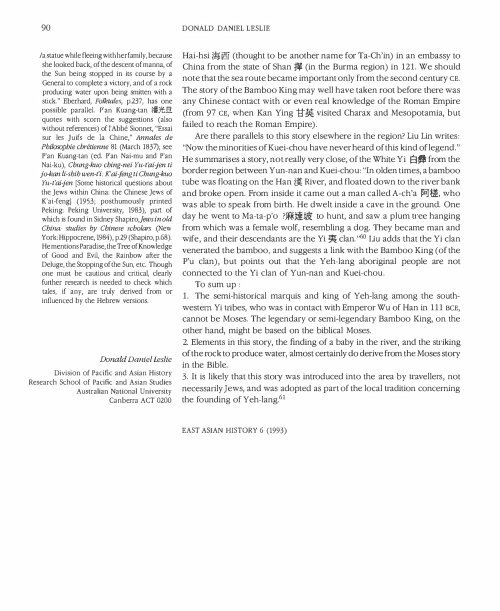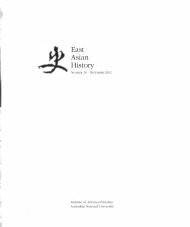(Donald Daniel Leslie) (PDF 4.7MB) - ANU
(Donald Daniel Leslie) (PDF 4.7MB) - ANU
(Donald Daniel Leslie) (PDF 4.7MB) - ANU
You also want an ePaper? Increase the reach of your titles
YUMPU automatically turns print PDFs into web optimized ePapers that Google loves.
90<br />
DONALD DANIEL LESLIE<br />
fa statue while fleeing with her family, because<br />
she looked back, of the descent of manna, of<br />
the Sun being stopped in its course by a<br />
General to complete a victory, and of a rock<br />
producing water upon being smitten with a<br />
stick." Eberhard, Fo/kf£lles, p.237, has one<br />
possible parallel. P'an Kuang-tan nlJlCEl.<br />
quotes with scorn the suggestions (also<br />
without references) of l'Abbe Sionnet, "Essai<br />
sur les Juifs de la Chine," Annates de<br />
Philosophie cbretienne 81 (March 1837); see<br />
P'an Kuang-tan (ed. P'an Nai-mu and P'an<br />
Nai-ku), Chung-kuo ching-nei Yu-t'ai-jen ti<br />
jo-kan /i-shih wen-t'i: K'ai-feng ti Chung-kuo<br />
Yu-t'ai-jen [Some historical questions about<br />
the Jews within China: the Chinese Jews of<br />
K'ai-fengJ (1953; posthumously printed<br />
Peking: Peking University, 1983), part of<br />
which is found in Sidney Shapiro,jews in old<br />
China: studies by Chinese scholars (New<br />
York: Hippocrene, 1984), p.29 (Shapiro, p.68).<br />
He mentions Paradise, the Tree of Knowledge<br />
of Good and Evil, the Rainbow after the<br />
Deluge, the Stopping of the Sun, etc. Though<br />
one must be cautious and critical, clearly<br />
further research is needed to check which<br />
tales, if any, are truly derived from or<br />
influenced by the Hebrew versions.<br />
<strong>Donald</strong> <strong>Daniel</strong> <strong>Leslie</strong><br />
Division of Pacific and Asian History<br />
Research School of Pacific and Asian Studies<br />
Australian National University<br />
Canberra ACT 0200<br />
Hai-hsi jffi (thought to be another name for Ta-Ch'in) in an embassy to<br />
China from the state of Shan N. (in the Burma region) in 121. We should<br />
note that the sea route became important only from the second century CEo<br />
The story of the Bamboo King may well have taken root before there was<br />
any Chinese contact with or even real knowledge of the Roman Empire<br />
(from 97 CE, when Kan Ying 1:t: visited Charax and Mesopotamia, but<br />
failed to reach the Roman Empire).<br />
Are there parallels to this story elsewhere in the region liu Lin writes:<br />
"Now the minorities of Kuei-chou have never heard of this kind of legend."<br />
He summarises a story, not really very close, of the White Yi 6. from the<br />
border region between Yun-nan and Kuei-chou: "In olden times, a bamboo<br />
tube was floating on the Han River, and floated down to the river bank<br />
and broke open. From inside it came out a man called A-ch'a Mm, who<br />
was able to speak from bitth. He dwelt inside a cave in the ground. One<br />
day he went to Ma-ta-p'o JffJ.iiBt to hunt, and saw a plum u'ee hanging<br />
from which was a female wolf, resembling a dog. They became man and<br />
wife, and their descendants are the Yi clan. , ,60 liu adds that the Yi clan<br />
venerated the bamboo, and suggests a link with the Bamboo King (of the<br />
P'u clan), but points out that the Yeh-lang aboriginal people are not<br />
connected to the Yi clan of Yun-nan and Kuei-chou.<br />
To sum up :<br />
1. The serni-histotical marquiS and king of Yeh-lang among the southwestern<br />
Yi robes, who was in contact with Emperor Wu of Han in 111 BCE,<br />
cannot be Moses. The legendary or semi-legendary Bamboo King, on the<br />
other hand, might be based on the biblical Moses.<br />
2. Elements in this story, the finding of a baby in the liver, and the sU'iking<br />
of the rock to produce water, almost certainly do derive from the Moses story<br />
in the Bible.<br />
3. It is likely that this stOlT was introduced into the area by u-avellers, not<br />
necessatily Jews, and was adopted as part of the local u-adition concerning<br />
the founding of Yeh-lang.61<br />
EAST ASIAN HISTORY 6 (1993)
















